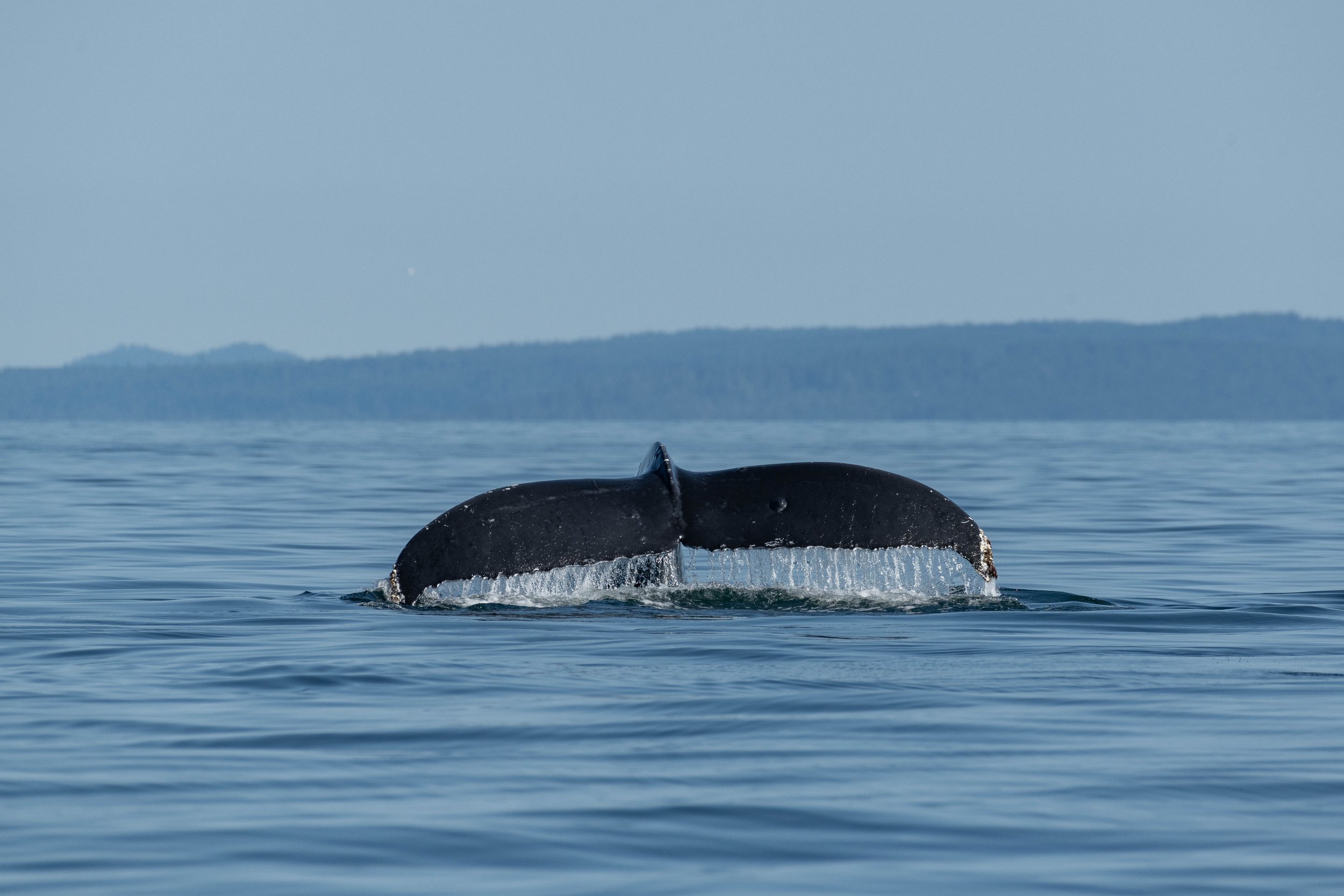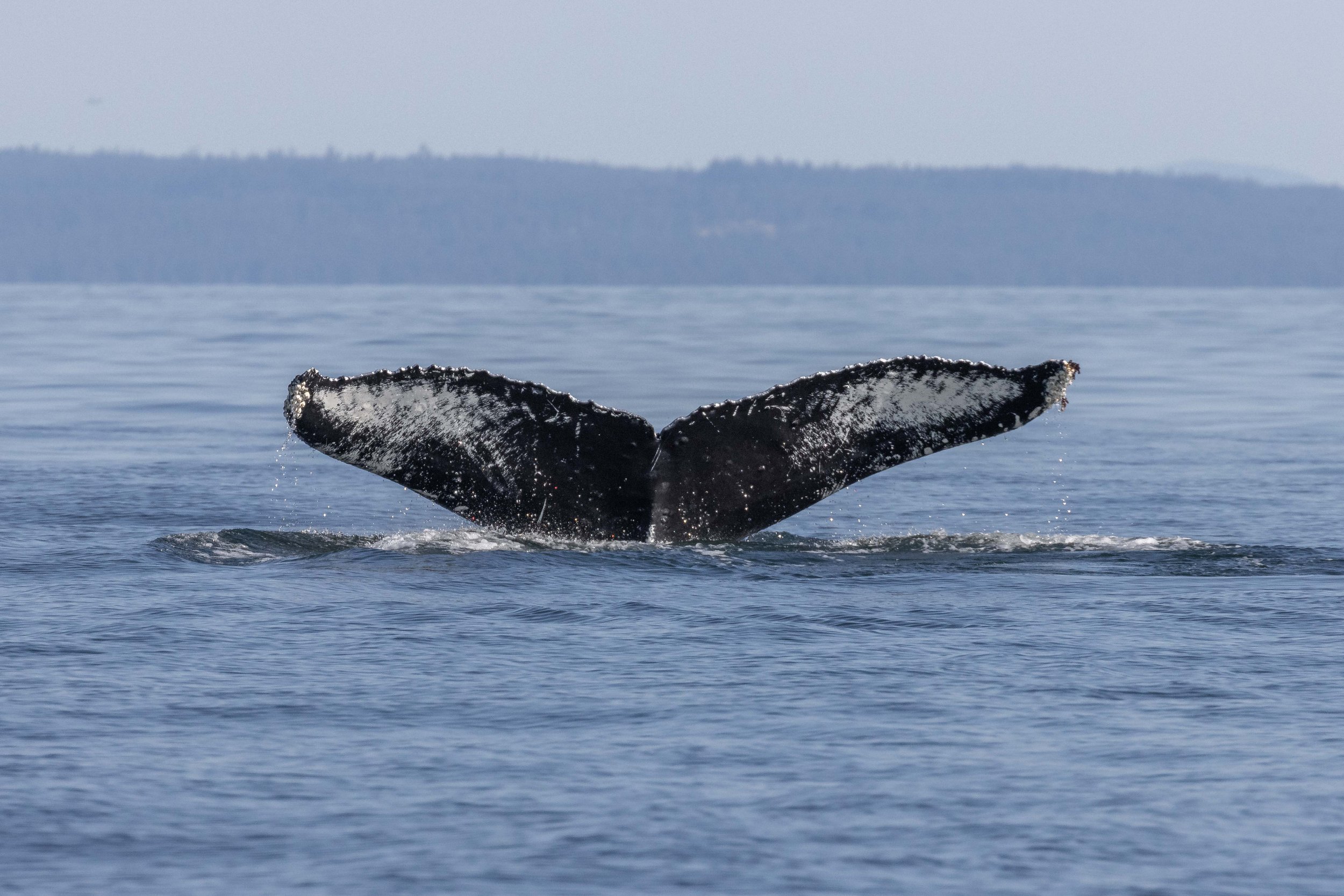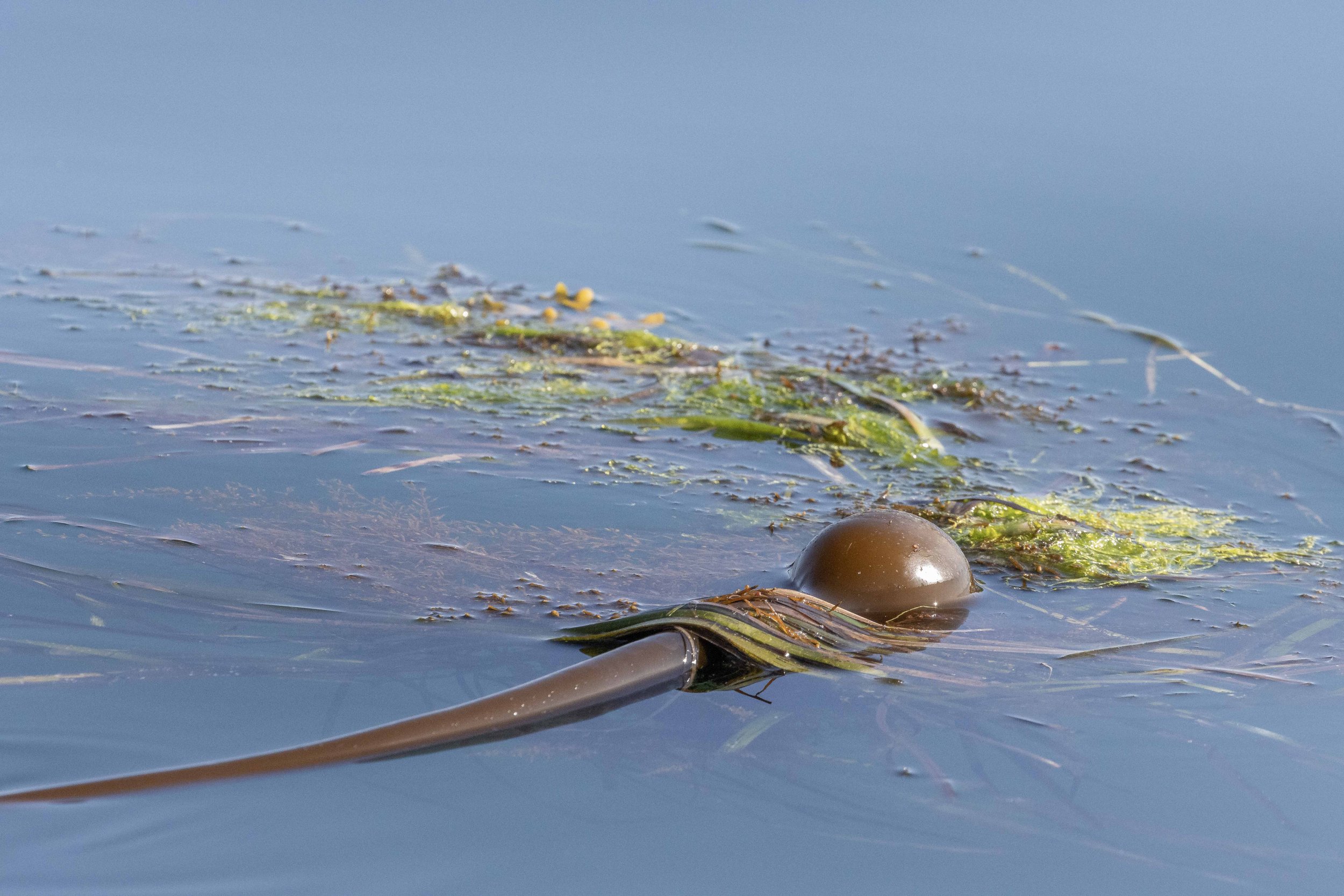July 20, 2024, 3:30 pm - A mini T-party and some Humpback Whales
We had started out the day on July 20th with both species that were close to Nanaimo, but headed North, so we decided to also head that way and see if we couldn’t find them again! It was a lovely, calm day so it made conditions perfect for searching. We scanned along the horizon until we spotted them, it was the splashing of Orca in the distance! We confirmed that it was indeed the same group that we had saw this morning, the T075Bs, some of the T077s, and T065A5 travelling together.
T065A5 Indy ♂ (2014)
T075B Pebbles ♀ (1995)
T075B2 Jasper ♀ (2015)
T075B3 Rubble (2017)
T075B4 (2021)
T077 Asja ♀ (1981)
T077E Misneach (2016)
These 7 orca seemed to be hunting when we found them this time, with quick movement at the surface and sticking around in one spot for most of the time. The best sign we got to confirm that they were hunting was when one of the orca surfaced with hard evidence for us in the way of the Harbour Seal’s Intestines draped over their dorsal fin. This happens once in a while, given that they are very social and tactile creatures, they are likely showing off to each other while also getting a nice massage from their food. It’s the ultimate example of playing with your food!
Orca need to have good store of energy, given some challenges with the environment that they live in. Living in water means that there is a greater exchange of heat than there is in air, about 25x the amount of heat conduction to be exact. There are lots of adaptations that the whales have to deal with this, including the thick layer of blubber and their large size. The blubber helps insulate them from the colder water, making it so their skin is cooler than their internal body temperature. This internal temperature is produced by the whales metabolism, as all warm blooded creatures are. This means that the are turning the energy from their food partially into heat, to keep things at the right temperature. Their large size also helps reduce heat transfer, as they would have less surface area on their bodies to exchange the heat with the water and a large internal volume to produce and maintain the heat. There are a few large cold bodied animals that have higher body temperatures than ambient that also use these methods, like the tuna who have so much muscle movement with their high speed that they produce heat, and large enough bodies that it doesn’t exchange the heat with the water as quickly as they are producing it.
Today while watching the whales having their snack, we couldn’t help but think about how important the energy they were gaining would be for maintaining their energy for movement, heat production, and to maintain their insulating blubber layer.
Eventually, it came time to leave the whales to it, and we continued to see what else we might be able to find on our way home, and the answer was humpback whales! It was a pair of humpbacks travelling closely together that we came across first; Big Mama (BCY0324) and Olympus (BCX2075)! These two seemed like they were also feeding when we first found them, doing deeper dives between their breathing intervals. We also saw Big Mama “snaking” which is where they move their head up and down in the water. This is thought to help them keep their baleen plates clean, similar to us flossing! The food with these two must have been good, since they got acrobatic towards the end of our time with them, with one of the pair breaching out of the water and following it up with some chin slapping. It was quite the sight to behold, though short lived. After this they continued on their feeding journey.
The final whale that we came across today was a quick look at Coyote (BCX0837calf2021). Coyote was feeding in the area as well, a great indication that there is plenty of food for our whales in the area that they are taking full advantage of! We left Coyote to it and headed back to Nanaimo.
Both boats stopped briefly at Snake Island to see the Harbour Seals that haul out there, and were treated to a look at a small pup that was sunning itself on the rocks. There was also a few Black Oyster Catchers that we were able to get a glimpse of here! Finally, the tours concluded with a stop at the Gabriola Bluffs to get a look at the Cormorants and Pigeon Guillemots that spend their time there.
The onboard Marine Naturalists Aly Kohlman and Vanessa Vereschahen captured some amazing photos during this trip, all of which can be viewed below!
T075B4 spy hopping, slightly out of focus but too cool to not include! Photo by Aly Kohlman.
Some Surfbirds flying by while we spent time with the whales. Photo by Aly Kohlman.
T075B2 Fifi trailing some intestine on his dorsal fin with T075B3 just behind. Photo by Aly Kohlman.
Someone tail slapping during the excitement. Photo by Aly Kohlman.
T065A5 Indy travelling with the others. Photo by Aly Kohlman.
Photo by Aly Kohlman.
Photo by Aly Kohlman.
T075B Pebbles surfacing in the calm water. Photo by Aly Kohlman.
T077 Asja surfacing. We can match the unique scarring on her saddle patch to ID her. Photo by Aly Kohlman.
T075B Pebbles with her eye patch visible behind the wave. Photo by Aly Kohlman.
T065A5 Indy has a distinct notch. Photo by Vanessa Vereschahen.
T075B Pebbles surfacing. Photo by Vanessa Vereschahen.
One of the whales coming towards the camera. Look how wide they are! Photo by Vanessa Vereschahen.
A close up look at T077 Asja’s eye patch. Photo by Vanessa Vereschahen.
T077 Asja arching for a dive. Photo by Vanessa Vereschahen.
A very close look at T077E Misneach’s eye patch and you can see their closed eye. Photo by Vanessa Vereschahen.
Big Mama lifting her tail with Olympus’s dorsal fin in the background. Photo by Aly Kohlman.
A great look at the underside of Big Mama’s tail flukes. Photo by Aly Kohlman.
Big Mama creating a fluke waterfall as she prepares to dive. Photo by Aly Kohlman.
These white pigments and scars help us ID the whales. Photo by Aly Kohlman.
Olympus lifting her tail to dive. Photo by Aly Kohlman.
The underside of Coyote’s tail flukes, Photo by Aly Kohlman.
Big Mama or Olympus preparing for a chin slap. Photo by Aly Kohlman.
Big Mama or Olympus chin slapping again! Photo by Aly Kohlman.
A nice breach from Big Mama or Olympus. Photo by Aly Kohlman.
Olympus creating a fluke waterfall as she dives. Photo by Vanessa Vereschahen.
The underside of Olympus’ fluke. Photo by Vanessa Vereschahen.
Big Mama diving on the left, with Olympus on the right. Photo by Vanessa Vereschahen.
Olympus diving. Photo by Vanessa Vereschahen.
The underside of Olympus’s tail! Those white markings are scars which help us ID her. Photo by Vanessa Vereschahen.
A nice high fluke from Olympus. Photo by Vanessa Vereschahen.
Big Mama’s tail flukes. Photo by Vanessa Vereschahen.
Some Bull Kelp floating by, knocked loose by the tide and winds. Photo by Vanessa Vereschahen.
Big Mama “snaking” while we watched her. Photo by Vanessa Vereschahen.
Dorsal fins of Olympus (left) and Big Mama (right). Photo by Vanessa Vereschahen.
Olympus going for one last dive! Photo by Vanessa Vereschahen.
A black oyster catcher balancing on one leg. Photo by Aly Kohlman.
Harbour Seals (with a pup) at Snake Island. Photo by Vanessa Vereschahen.
A very happy looking Harbour Seal on the Rocks. Photo by Vanessa Vereschahen.
A gull family along the Gabriola Bluffs. Photo by Vanessa Vereschahen.
A Pigeon Guillemot with its catch along the bluffs. Photo by Vanessa Vereschahen.
TWO Pigeon Guillemots with their catches along the bluffs. Photo by Vanessa Vereschahen.










































